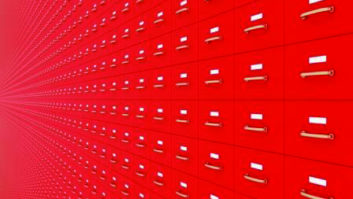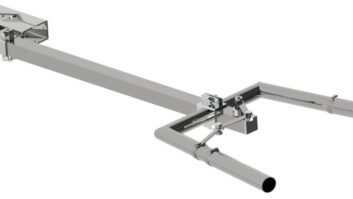Many years ago, in the mid-1980s, I was charged with the task of improving the signal and coverage of our Chicago Class B FM station. At the time, that station was operating at 30 kW and 400 feet above average terrain. My task was to get it up to full Class B facilities, which was not an easy task because of grandfathered short spacings; but that’s a story for another time.

After much engineering as well as months and months of wrestling with the FAA, I did get approval for a 525-foot tower and a CP from the FCC for a full 50 kW with the height increase. What a thrill it was when that document came in the mail! But then I saw an ominous special condition on the last page of the CP. There was an AM directional array less than two miles distant, and the FCC was requiring me to make pre- and post-construction proof measurements on the station.
As it turned out, that station was in bad shape. I don’t remember all the particulars, but when I contacted their Washington consulting engineer for the documentation from the last full proof, something of a panic started with the licensee. From what I could gather, the pattern was out of tolerance, monitor points were probably high and the sampling system was damaged.
The licensee certainly did not want me making measurements and submitting them to the FCC showing those issues, so I was provided with a letter from the licensee, which the FCC accepted, taking all responsibility for any pattern disturbance that might result from the construction of our new tower. With that in hand, I was able to go ahead and build, and the rest is history.
IT COULD HAVE BEEN WORSE
I did recognize, however, that I had, to some degree, dodged a bullet. Running a partial proof on that six-tower directional array twice would have taken a lot of time and effort (there were 16 radials, if I recall correctly).
Since then, I have been on both sides of the AM directional array issue many times. Starting in the early 1990s, it seems that there was always a cell tower or monopole going up close to one of our arrays somewhere. With limited tools to evaluate the potential impact, we often resorted to pre- and post-construction monitor point measurements, which provided ambiguous information at best.
And then I ran into the loophole in the FCC’s rules for protection of AM antenna systems from nearby tower construction. Other than broadcast, wireless and public mobile services, there were no rules in place to require other FCC permittees to protect such antennas. Part 90 (Private Land Mobile) licensees in particular did not have to make notification, perform measurements or provide detuning. The county sheriff could build his dispatch tower right across the road from an AM antenna, totally wreck the pattern and have no liability at all, and it happened a lot, all over the country.
FULL PROTECTION AT LAST
A number of years ago, the AM Directional Antenna Performance Verification Coalition, the group that was the impetus behind the moment-method model proof rules that went into effect a few years ago, began pushing for some omnibus AM antenna protection rules. Last August, the FCC finally enacted those rules, and by the time you read this, the rules should be in effect.

These rules were placed in Part 1 of Title 47 of the Code of Federal Regulations, “Practice and Procedure” (§1.30001 – §1.30004). That placement makes them applicable to all services regulated by the FCC. While the rules have many provisions and requirements, a good understanding can be had by hitting the high points.
First, the FCC set some screens for distance and height that will eliminate a lot of structures from consideration. Distances and heights were based on the AM station’s frequency (rather than employing a straight distance/height screen).
For structures near non-directional AM antennas, only towers within one wavelength that are taller than 60 electrical degrees at the AM frequency must be considered, and detuning is required only if a pattern disturbance of more than 2 dB results.
For structures near directional AM antennas, only those within the lesser of 10 wavelengths or 3 km and taller than 36 electrical degrees at the AM frequency must be considered. Detuning is required if radiation on any azimuth exceeds the AM station’s licensed standard pattern.
Towers mounted on buildings no longer have to be considered unless the tower itself (not the tower and the building combined) meets the above criteria.
It seems that wireless licensees are always making changes to their antenna systems and towers, and the FCC set some screens in the new rules for modification of existing structures to help weed out insignificant changes.
Specifically, these screens are a height change of more than five electrical degrees at the AM frequency for non-detuned, non-insulated towers; or the addition or replacement of one or more antennas or transmission lines on towers that are detuned or base insulated. Those screens will take care of the vast majority of such modifications while protecting the AM pattern where a tower has already been detuned.
STATION RECOURSE
Suppose that an antenna structure that falls outside the screens is built and the AM licensee notices a corresponding change in his antenna pattern. What then?
The new rules provide for this. The AM licensee can, within two years, make and submit a showing, using either moment-method modeling or measurements, and if the FCC agrees that the pattern was indeed disturbed, it can order detuning. A moment-method showing can be made before construction if an AM licensee suspects that a proposed tower outside the screen distance and/or height would have an impact on his pattern.
Moment-method (MoM) modeling has long been used by consulting engineers as a tool to evaluate the effect that a nearby antenna structure may have on the radiation pattern of an AM antenna, and in the new rules, the FCC made use of MoM modeling a requirement for such evaluations. Alternatively, for stations licensed pursuant to a conventional proof, before- and after-construction monitor point measurements can be used to show no change in the pattern
Something I was concerned about as we proposed these new rules was existing “exempt” structures. Other coalition members and I have arrays that have been impacted by towers for Part 90 and other formerly exempt services. What about those? The FCC provided a one-year window after the new rules go into effect for affected AM licensees to submit showings demonstrating pattern distortion as a result of such nearby antenna structures. If the FCC, after examining a showing, agrees that the structure is causing impermissible pattern distortion, it can order detuning.
The rules also contain criteria for mounting various antennas on AM towers. These rules mostly replace those from Part 73 that were deleted and moved to Part 1. In a nutshell:
● When installing antennas on a non-directional AM tower, if the base resistance changes by more than 2 percent, a Form 302-AM must be filed.
● When installing on a conventionally-proofed AM directional array tower, a partial proof must be run and filed with a Form 302-AM.
● When installing on a MoM-proofed AM directional array tower, if the base impedance of the tower changes by more than ±2 ohms and ±4 percent resistance and reactance, a new model must be run and filed.
GOOD FOR AM
These new rules provide a win for just about everyone. They are a win for AM licensees because they provide good protection for their antenna patterns. They are a win for wireless licensees because they eliminate many of the costly and labor-intensive measurements they have long had to do when constructing or modifying their facilities. And they are a win for the FCC as they can eventually do away with many of the “permanent STAs” under which AM stations with pattern distortion from exempt structures operate. The only folks that may not be too happy are the licensees of existing pattern-disturbing structures that may have to add detuning.
If I were building that Chicago FM tower today, it would be a simple matter of running a moment-method model on the AM array, then adding a “wire” representing the FM tower and running the model again. A comparison of the predicted pattern and the electric fields on the null and lobe radials would show that the FM tower had no effect on the AM pattern. I would then file this as a showing with my Form 302-FM license application.
That would certainly be a lot less work than beating the bushes for a couple of weeks running before and after proofs on the station. And the AM licensee could rest assured that his pattern would be undisturbed. I’d call that a win all the way around.
Cris Alexander is the director of engineering at Crawford Broadcasting and a past recipient of SBE’s Broadcast Engineer of the Year award.











